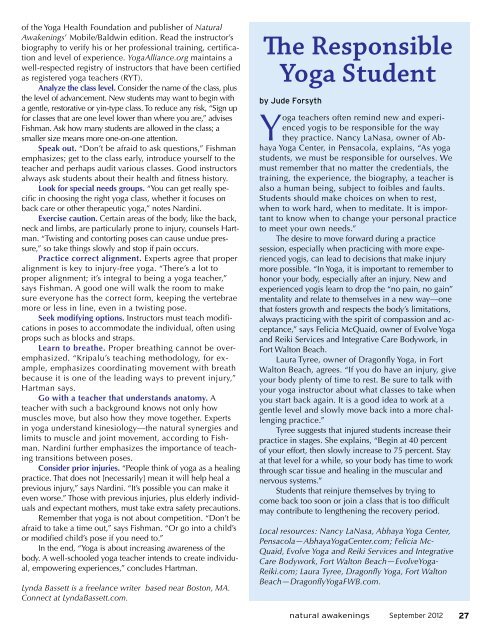Do You Have A Wheat Belly? - Natural Awakenings
Do You Have A Wheat Belly? - Natural Awakenings
Do You Have A Wheat Belly? - Natural Awakenings
Create successful ePaper yourself
Turn your PDF publications into a flip-book with our unique Google optimized e-Paper software.
of the Yoga Health Foundation and publisher of <strong>Natural</strong><br />
<strong>Awakenings</strong>’ Mobile/Baldwin edition. Read the instructor’s<br />
biography to verify his or her professional training, certification<br />
and level of experience. YogaAlliance.org maintains a<br />
well-respected registry of instructors that have been certified<br />
as registered yoga teachers (RYT).<br />
Analyze the class level. Consider the name of the class, plus<br />
the level of advancement. New students may want to begin with<br />
a gentle, restorative or yin-type class. To reduce any risk, “Sign up<br />
for classes that are one level lower than where you are,” advises<br />
Fishman. Ask how many students are allowed in the class; a<br />
smaller size means more one-on-one attention.<br />
Speak out. “<strong>Do</strong>n’t be afraid to ask questions,” Fishman<br />
emphasizes; get to the class early, introduce yourself to the<br />
teacher and perhaps audit various classes. Good instructors<br />
always ask students about their health and fitness history.<br />
Look for special needs groups. “<strong>You</strong> can get really specific<br />
in choosing the right yoga class, whether it focuses on<br />
back care or other therapeutic yoga,” notes Nardini.<br />
Exercise caution. Certain areas of the body, like the back,<br />
neck and limbs, are particularly prone to injury, counsels Hartman.<br />
“Twisting and contorting poses can cause undue pressure,”<br />
so take things slowly and stop if pain occurs.<br />
Practice correct alignment. Experts agree that proper<br />
alignment is key to injury-free yoga. “There’s a lot to<br />
proper alignment; it’s integral to being a yoga teacher,”<br />
says Fishman. A good one will walk the room to make<br />
sure everyone has the correct form, keeping the vertebrae<br />
more or less in line, even in a twisting pose.<br />
Seek modifying options. Instructors must teach modifications<br />
in poses to accommodate the individual, often using<br />
props such as blocks and straps.<br />
Learn to breathe. Proper breathing cannot be overemphasized.<br />
“Kripalu’s teaching methodology, for example,<br />
emphasizes coordinating movement with breath<br />
because it is one of the leading ways to prevent injury,”<br />
Hartman says.<br />
Go with a teacher that understands anatomy. A<br />
teacher with such a background knows not only how<br />
muscles move, but also how they move together. Experts<br />
in yoga understand kinesiology—the natural synergies and<br />
limits to muscle and joint movement, according to Fishman.<br />
Nardini further emphasizes the importance of teaching<br />
transitions between poses.<br />
Consider prior injuries. “People think of yoga as a healing<br />
practice. That does not [necessarily] mean it will help heal a<br />
previous injury,” says Nardini. “It’s possible you can make it<br />
even worse.” Those with previous injuries, plus elderly individuals<br />
and expectant mothers, must take extra safety precautions.<br />
Remember that yoga is not about competition. “<strong>Do</strong>n’t be<br />
afraid to take a time out,” says Fishman. “Or go into a child’s<br />
or modified child’s pose if you need to.”<br />
In the end, “Yoga is about increasing awareness of the<br />
body. A well-schooled yoga teacher intends to create individual,<br />
empowering experiences,” concludes Hartman.<br />
Lynda Bassett is a freelance writer based near Boston, MA.<br />
Connect at LyndaBassett.com.<br />
The Responsible<br />
Yoga Student<br />
by Jude Forsyth<br />
Yoga teachers often remind new and experienced<br />
yogis to be responsible for the way<br />
they practice. Nancy LaNasa, owner of Abhaya<br />
Yoga Center, in Pensacola, explains, “As yoga<br />
students, we must be responsible for ourselves. We<br />
must remember that no matter the credentials, the<br />
training, the experience, the biography, a teacher is<br />
also a human being, subject to foibles and faults.<br />
Students should make choices on when to rest,<br />
when to work hard, when to meditate. It is important<br />
to know when to change your personal practice<br />
to meet your own needs.”<br />
The desire to move forward during a practice<br />
session, especially when practicing with more experienced<br />
yogis, can lead to decisions that make injury<br />
more possible. “In Yoga, it is important to remember to<br />
honor your body, especially after an injury. New and<br />
experienced yogis learn to drop the “no pain, no gain”<br />
mentality and relate to themselves in a new way—one<br />
that fosters growth and respects the body’s limitations,<br />
always practicing with the spirit of compassion and acceptance,”<br />
says Felicia McQuaid, owner of Evolve Yoga<br />
and Reiki Services and Integrative Care Bodywork, in<br />
Fort Walton Beach.<br />
Laura Tyree, owner of Dragonfly Yoga, in Fort<br />
Walton Beach, agrees. “If you do have an injury, give<br />
your body plenty of time to rest. Be sure to talk with<br />
your yoga instructor about what classes to take when<br />
you start back again. It is a good idea to work at a<br />
gentle level and slowly move back into a more challenging<br />
practice.”<br />
Tyree suggests that injured students increase their<br />
practice in stages. She explains, “Begin at 40 percent<br />
of your effort, then slowly increase to 75 percent. Stay<br />
at that level for a while, so your body has time to work<br />
through scar tissue and healing in the muscular and<br />
nervous systems.”<br />
Students that reinjure themselves by trying to<br />
come back too soon or join a class that is too difficult<br />
may contribute to lengthening the recovery period.<br />
Local resources: Nancy LaNasa, Abhaya Yoga Center,<br />
Pensacola—AbhayaYogaCenter.com; Felicia Mc-<br />
Quaid, Evolve Yoga and Reiki Services and Integrative<br />
Care Bodywork, Fort Walton Beach—EvolveYoga-<br />
Reiki.com; Laura Tyree, Dragonfly Yoga, Fort Walton<br />
Beach—DragonflyYogaFWB.com.<br />
natural awakenings September 2012<br />
27








